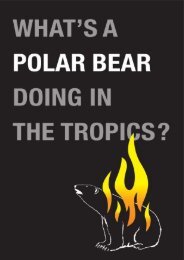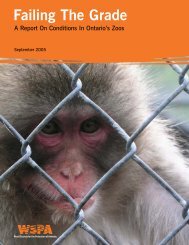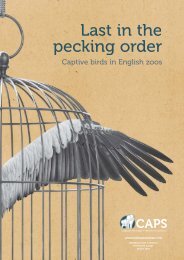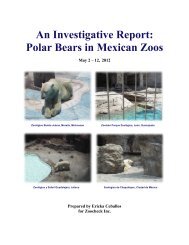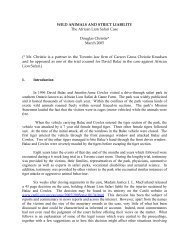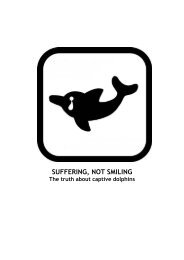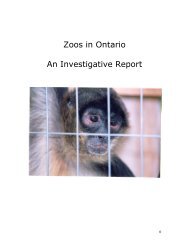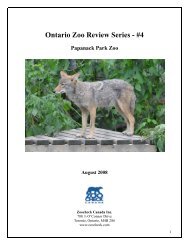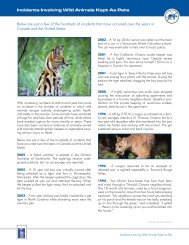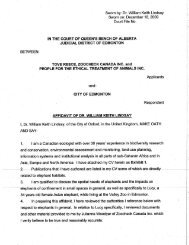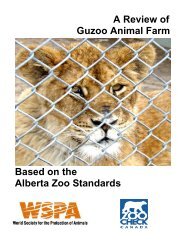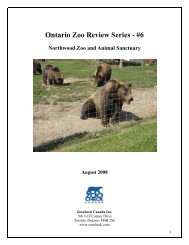review of Discovery Wildlife Park - Zoocheck Canada
review of Discovery Wildlife Park - Zoocheck Canada
review of Discovery Wildlife Park - Zoocheck Canada
Create successful ePaper yourself
Turn your PDF publications into a flip-book with our unique Google optimized e-Paper software.
Animal Care and ConfinementThe stated purpose <strong>of</strong> the animal exhibit standards is “to ensure the exhibitsmeet the needs <strong>of</strong> the animals that will occupy them” and yet the animals at<strong>Discovery</strong> <strong>Wildlife</strong> <strong>Park</strong> continue to live in impoverished enclosures and somewithout the most basic necessities such as fresh and appropriate food andpotable water.Food & Water: Section III. E. General Animal Care Standards states that“Animals must be provided with nutritious food as set out in the veterinary writtenagreement and a potable water source must be available to all animals at alltimes.” And “Feeding and watering containers must be kept clean and selffeedersand watering devices must be checked daily.”Since the Alberta government chose not to provide us with a copy <strong>of</strong> DWP’sdevelopment plan, which would include the veterinary written agreement, whichoutlines the recommended diet for the animals, compliance with the diet section<strong>of</strong> the standards cannot be determined. However, “rotting” carcasses <strong>of</strong> smallrodents and birds were scattered around the badger enclosure.Cleanliness <strong>of</strong> cages: Section III. E. General Animal Care Standards statesthat “Buildings and substrates to which animals have access must be kept cleanas follows:• Washable surfaces must be washed clean and disinfected regularly toprevent potentially dangerous accumulations <strong>of</strong> organic and inorganicmaterials and organisms.• Substrates which cannot be washed must be cleaned <strong>of</strong> gross waste (e.g.,perishable food and animal waste) on a daily basis (enclosures smallerthan 0.5 acres) and less frequently for larger enclosures. The animal careprotocol may indicate longer cleaning intervals for some species to reducepsychological stress. To facilitate cleaning all areas <strong>of</strong> the enclosuresmust be accessible to keepers.• Substrates such as loose bedding material must be changed if soiled withfeces and urine and any bedding provided must be kept dry and changedon a regular basis.”The Grizzly bear enclosure contains a hand dug pool without recirculationsystems or the ability to empty and refill the pools easily. As a result, the water inthe pool is filthy and may be a source <strong>of</strong> bacteria that would pose a health risk tothe bears and possibly the public if there is any overflow from excessive rainfallor snow melting in the spring.2
The water in this pond in the grizzly bear enclosure is filthyOvercrowding and enclosure size: Section III. B. 1. General Exhibit Standardsstates that “Exhibit enclosures must be <strong>of</strong> a sufficient size to provide for thephysical well being <strong>of</strong> the animal. All animal exhibits must be <strong>of</strong> a size andcomplexity sufficient to provide for the animal’s physical and social needs andspecies typical behaviours and movements.” And that “Enclosures must be <strong>of</strong> asufficient size and design to allow individual animals the opportunity to avoid orwithdraw from contact with other animals in the enclosure or remove themselvesfrom the view <strong>of</strong> visitors using topography (e.g. large earth mounds, large rocks),fixed features (e.g. fences, walls screening, shelter boxes), moveable fixtures(e.g. brush piles, root balls) or other design methods.”A number <strong>of</strong> DWP’s enclosures are poorly designed, undersized and do not allowthe animals to express a full range <strong>of</strong> their natural movements and behaviours.For example:• The staff indicated that the lion,leopard and tigers are locked intothe back areas when the facility isnot open, meaning the cats spend12-16 hours per day in dark substandardareas which are not largeenough to allow the animals toexercise or bathe. In addition therevery little light and poor ventilation inthese areas.• The badger, raccoon and porcupineenclosures are too small toaccommodate running, climbing orwalking any distance.. This dark, barren room is where the large cats arehoused when the zoo is closed.In addition, a number <strong>of</strong> animals do not have adequate privacy opportunitiesincluding the tiger, black bears, leopards, lions and the grizzly bears. The onlyway these animals can have privacy is to enter their sleeping boxes or <strong>of</strong>f exhibit,“winter” holding area. In some cases this is not even an option because theanimals are locked out during the hours the facility is open to the public.Breeding: Section II. A. Animal Collection Management Standards states that“Breeding <strong>of</strong> animals in the zoo facility may take place if it is approved as part <strong>of</strong>3
the Zoo Development Plan. If not approved, breeding must be preventedthrough drug therapy, appropriate management (i.e. opposite sexes kept inseparate enclosures) or sterilization.”Information provided by the Alberta government through a Freedom <strong>of</strong>Information request did not include any documentation regarding which species<strong>of</strong> animals the owner is permitted to breed, so we were unable to determinecompliance with this section <strong>of</strong> the standards. However, infant macaques wereobserved at the zoo. While having infants in the group helps to form anappropriate social group, there are concerns about the group becoming too largefor the enclosure and about what will happen to the surplus animals given thatthese animals are plentiful in zoos and the exotic pet trade. In addition, therewere young elk, deer, caribou and wolf pups.Shelter from the elements: Section III. B. 1. General Exhibit Standards statesthat “Animals must be protected from injurious heat and cold associated withambient outdoor conditions or any other weather conditions that are detrimentalto their health.”A number <strong>of</strong> enclosures do not have adequate shelter to protect all animals, atthe same time if necessary, from heat, cold, sun, rain, wind and snow. Theseinclude the elk, caribou, white-tailed deer, camels, Japanese macaques,leopards and ostrich enclosures.In captivity, all animals should be provided with shelter and shade opportunities.Enrichment for animals: Section III. D. Animal Behaviour HusbandryStandards states that “The purpose <strong>of</strong> these standards is to facilitatedevelopment <strong>of</strong> animal enrichment that improves the psychological well being <strong>of</strong>the animals. Enrichment consists <strong>of</strong> a range <strong>of</strong> measures, including fixed exhibitfeatures, non-fixed features and novel objects that attempt to provide a morestimulating environment for the animals.” And that “there must be a writtendocument outlining an enrichment program for each species, species group orspecies assemblage (if appropriate) at the exhibit level that may include fixedfeatures, non-fixed features and how food is made available.”The Alberta government chose not to provide <strong>Zoocheck</strong> with a copy <strong>of</strong> DWP’senrichment plan through the Freedom <strong>of</strong> Information process, so compliance withthe plan cannot be determined.4
Lack <strong>of</strong> enrichment for animals at DWP continues to be an ongoing problem.The following enclosures did not have adequate enrichment, such as furnishingsand browsing opportunities, to keep the animals physically and psychologicallyengaged and active: tigers, black bear, ungulates, badger and porcupine.This tiger enclosure provides no enrichment to encourage natural behavioursThis black bear enclosure is devoid <strong>of</strong> enrichment with <strong>of</strong>ten results in bears becoming bored and developing abnormalbehaviourPoorly equipped, relatively barren enclosures do not encourage species typicalmovements and behaviours. Many animals appear lethargic, possibly becausethey have nothing to do.Safety risks to animals: Section III. D. Animal BehaviourHusbandry Standards states that “The zoo operator must ensurethat any new materials introduced in an enclosure are not toxic tothe enclosed species.”This unmarked felid enclosure (appeared to be a bobcat)contained a plastic bag next to the shelter.Public feeding: Section III. B. 1. General Exhibit Standards states that “Feeding<strong>of</strong> animals by visitors must not be allowed except in specific circumstanceswhere food prepared by the zoo is provided to the public and amounts arecarefully controlled.5
There is animal food available for purchase at theshop near the entrance to the zoo marked “monkeyfeed”. Zoo visitors were observed feeding raccoonsand primates without supervision <strong>of</strong> zoo staff.ContainmentThe stated purpose for containment standards is “to prevent direct contactbetween zoo animals and free-ranging wildlife, domestic animals, and visitors tothe zoo facility; to prevent escape from the zoo facility; to prevent thetransmission <strong>of</strong> disease and/or parasites, and; to prevent interbreeding (geneticcontamination) between zoo animals and free-ranging wildlife.”Perimeter fence: Section II. D., <strong>Wildlife</strong> and Controlled Animal ContainmentStandards states that “A perimeter fence (equivalent to chain link fence) aminimum <strong>of</strong> 2.5 meters high all around all the animal enclosures will be required,unless the species held in the zoo facility already have a fully containedperimeter (e.g. amphibians and reptiles in cages within a building) or have analternate system as identified and approved in the Zoo Development Plan.”As stated previously, the Alberta government chose not to release the majority <strong>of</strong>DWP’s development plan through the Freedom <strong>of</strong> Information process, so we areunaware <strong>of</strong> any specialized agreement regarding an alternate perimetercontainment system. AT DWP, the perimeter fence does not to all around theentrance to the zoo from the parking lot. In addition, the back gate forms part <strong>of</strong>the perimeter fence and is left open and unsupervised.Gates in perimeter fence: Section II. D., <strong>Wildlife</strong> and Controlled AnimalContainment Standards states that “Individual animal enclosures and theperimeter fencing must be locked when the zoo facility is closed and staff are notpresent. When the zoo facility is open to the public, the perimeter fence may beunlocked; however, individual animal enclosures must remain locked exceptwhen staff are present and working with or displaying the animals.”While the regulations allow for the gates to be unlocked during the hours whenthe zoo facility is open, they do not permit gates to be left wide open.Pr<strong>of</strong>essionally operated zoos ensure that their public entry gates are set up sothat if an animal escapes while on the zoo property they still act as a secondarybarrier to contain the animal.This photo shows the open gate at the back<strong>of</strong> the zoo which is part <strong>of</strong> the perimeterfence. If an animal were to escape, theredoes not appear to be any immediate wayfor the zoo staff to close the gates andfocus on recapturing the animal.6
There is no perimeter fence at the entrance to the zoo near the parking lotThe slide door to the indoor portion <strong>of</strong> thisleopard enclosure is unlocked. These cats couldeasily lift the slide door enough to escapethrough the open door.Fencing for animals that dig: Section II. D. <strong>Wildlife</strong> and Controlled AnimalContainment Standards states that “Animals that can dig must have adequateflooring or material buried under the ground at the enclosure perimeter to preventthem from digging out <strong>of</strong> their enclosure or shelter.A number <strong>of</strong> enclosures housing species <strong>of</strong> animals that dig do not appear tohave buried fencing to keep the animals from digging their way out <strong>of</strong> their cages.These include the leopard, black & grizzly bear, tiger and lion enclosures.This is a hole in the ground at thefenceline in the grizzly bear enclosurewhere the bear appears to have beenattempting to dig under the fence.Fence strength: Section III. B. 1. General Exhibit Standards states that“Fencing must be <strong>of</strong> a design and strength suitable for the particular species and7
must be attached to posts firmly fixed intothe ground in a manner that preventsanimals from detaching the material ordislodging the posts.”At DWP, a number <strong>of</strong> animal enclosurebarriers are constructed <strong>of</strong> materials lackingthe strength and/or design to properlycontain the animals, should they besufficiently motivated to escape. Theseinclude the lion and tiger enclosures whichare made from chain-link fence with hotwire. In addition, this grizzly bearenclosure is made from fencing normally used to contain ungulates.Enclosures for animals that climb or jump: Section III. B. 1. General ExhibitStandards states that “Dangerous animals that can climb or jump must be kept incompletely fenced or walled enclosures with ro<strong>of</strong>s, or in enclosures with fencesor walls <strong>of</strong> the type and construction which prevents animals from jumping overor climbing up and over the top <strong>of</strong> the fences or walls, or enclosures surroundedby suitable dry moats or wet moats <strong>of</strong> adequate depth having sufficiently highouter-edge walls or fences above the water surfaces. These moats must besurrounded by fences, walls, hedges or other shrubbery sufficient to preventvisitor approaching to close to the edges <strong>of</strong> the moats.”There is no overhang or ro<strong>of</strong> on this tiger enclosure to keep the cats fromjumping out and there is a gap in the fencing above the shelter making it eveneasier for the animals to escape.In addition, some <strong>of</strong> the bears are kept behind hotwire and a short stand-<strong>of</strong>fbarrier. If a bear is sufficiently motivated a hotwire is not enough <strong>of</strong> a deterrent tokeep the animal from escaping. Therefore, this is not a safe method <strong>of</strong>containment.8
Public and Staff SafetyPublic contact with animals: Section II. H., Public and Staff Safety Standards,states that “Direct contact (i.e. touching) between the public and animals isallowed only when this activity is approved in the Zoo Development Plan. Suchcontact must occur in a contained area and all applicable Alberta Healthregulations must be followed.” And “Animals in areas where direct contact withvisitors is possible must pose no danger to the public, becomfortable with human contact and be under directsupervision by zoo staff.”For many years DWP has had a ‘kiss a grizzly bear’ attractionwhere visitors can be photographed having their face licked bya grizzly bear, kissing a bear or with a grizzly bear posing inan attack position behind them. While this activity is“supervised” by a zoo staff person, it does pose a significantrisk to the public. There are numerous examples <strong>of</strong> welltrained carnivores attacking people despite having been handraisedand trained. When this photo was taken, there was nokill weapon readily available to staff if something were to gowrong and the zoo staff person supervising this activity would be no match for anattacking grizzly bear.<strong>Zoocheck</strong> and WSPA consulted with various experts regarding the safety <strong>of</strong> thisactivity and were told the following:Victor Watkins, one <strong>of</strong> the world’s leading bear experts and wildlife advisorto WSPA advised that “This is certainly a foolish and irresponsible activityto put the public into such close quarters with a wild animal – no matterhow well “trained” the bear appears to be – the animal has wild instinctsand can react to evens in an unpredictable way. It is not good enough tosay the bear has not done anything to harm people before, as it could doso tomorrow or the next day. I have seen too many bears in captivityreact to a certain stimulus by swiping at people or objects which may nothave been an aggressive act but could nevertheless cause injury or evendeath to people. It is also a terribly negative educational message to havewild animals such as bears used in these circus-style acts as it gives thepublic the wrong impression about the animal. It does enhance a Disneylikeimage <strong>of</strong> animals and can create an impression that the animals arecute and cuddly and harmless, which can have a devastating effect if thatimage is taken into the wild when people try to feel wild bears etc.”Dr. Steve Herrero <strong>of</strong> the University <strong>of</strong> Calgary made the followingcomment about the “bear kissing” activity at DWP. “No valid educationcan be achieved through these kinds <strong>of</strong> displays, they only serve to teachthe public a false image that bears are gentle and kissable animal. Bearsare very dangerous animals and should always be treated with respect.”9
In addition, during the “behind-the-scenes” tour, a zoo staff person <strong>of</strong>fered anopportunity to touch or scratch a Siberian tiger and a woman was walking wolfpups on a leash and allowing children t0 pet the wolves. There were no handwashingstations anywhere near these activities.If these activities are sanctioned activities under the Zoo’s Development Plan, theAlberta government is complicit in placing the public at significant risk <strong>of</strong> injury orcontracting a zoonotic disease.Stand<strong>of</strong>f barriers: Section II. H., Public and Staff Safety Standards, states that“Effective guardrails or barriers must be constructed to prevent contact betweenthe visiting public and any animals posing a safety hazard.”There are a number <strong>of</strong> enclosures at DWP that do not have adequate barriers tokeep the public back from the animal enclosures. The enclosures withoutadequate stand<strong>of</strong>f barriers include the muntjac deer, camel, white-tailed deer,caribou, elk and ostriches.Double door entry: Section II. H., Public and Staff Safety Standards, states that“Animals must be safely confined. Enclosures with potentially dangerousanimals must have double door entry systems or a separate, secure shift areawhere the animals can be secured during routine maintenance, cleaning orveterinary care.”A number <strong>of</strong> enclosures that contain dangerous animals do not have double doorentry or shift cages to allow safe cleaning <strong>of</strong> cages and feeding, etc. Theseinclude the tiger, black bear, lion, leopard and grizzly bear enclosures.EducationSignage: Section II. G., Conservation Education Standards, states that “Thepurpose <strong>of</strong> these standards is to promote positive attitudes about wildlife byproviding information and knowledge to the public. The standards for educationprograms for wildlife and controlled animals in a zoo facility are:• The zoo must have an active educational program as outlined in the ZooDevelopment Plan and all exhibits must have signs that identify thespecies and provide information about the status and range in the wild.Educational programs may also include species not present at the zo<strong>of</strong>acility (e.g. SRD has information covering species at risk). See AppendixC for further information.”Appendix C containssuggestions for the type <strong>of</strong>information that could beincluded in educationprograms.”This felid enclosure had no signageindicating the species <strong>of</strong> cat or anyeducational information about thespecies. The small sign on the right <strong>of</strong>10
the photos says only “vanishing animal”.Since the Alberta government chose not to provide DWP’s educational programoutline from their Zoo Development Plan through the Freedom <strong>of</strong> Informationprocess, we are unable to determine compliance. However, it would be highlyirresponsible for a government to permit people to “kiss” grizzly bears, if this ispermitted within the plan. Given that the Alberta government is currently talkingabout the need for education about wild grizzly bears in order to protect thespecies, this activity is particularly irresponsible.Staff training: Section II. I., Staff Experience and Training Standards, statesthat “The purpose <strong>of</strong> these standards is to ensure that the keepers at the zoo,whether the owner, the operator or the staff (including volunteers), have thenecessary experience and training to ensure the zoo facility is operatedaccording to the standards in this document and good zoo practice.”The expectations <strong>of</strong> zoo staff are presumably outlined in DWP’s ZooDevelopment Plan, but <strong>Zoocheck</strong> and WSPA were denied access to themthrough the Freedom <strong>of</strong> Information process. Therefore we are unable todetermine if the facility is in compliance with these standards.Our investigator spoke with two zookeepers at DWP during the visit and was toldthat they do not have any formal training and that during their interview they weretold that if the animals respond positively to them when they approach theenclosures they would be hired.Record Keeping, Transportation and Animal Health: There are specificstandards outlined in the Government <strong>of</strong> Alberta Standards for Zoos in Alberta ineach <strong>of</strong> these areas, but because the Alberta government chose not to releasethat information through the Freedom <strong>of</strong> Information process, compliance cannotbe determined.Conclusion and Request for Enforcement <strong>of</strong> Provincial LegislationOur <strong>review</strong> <strong>of</strong> <strong>Discovery</strong> <strong>Wildlife</strong> <strong>Park</strong> revealed more than 50 individual violations<strong>of</strong> the Alberta zoo standards. Therefore, <strong>Zoocheck</strong> and WSPA request that theGovernment <strong>of</strong> Alberta to take immediate action to enforce its zoo standards,thereby bringing DWP into compliance with the regulations.11



